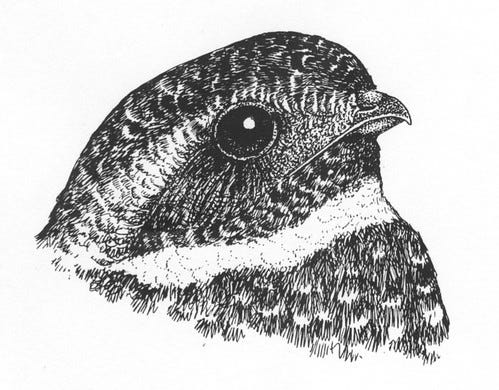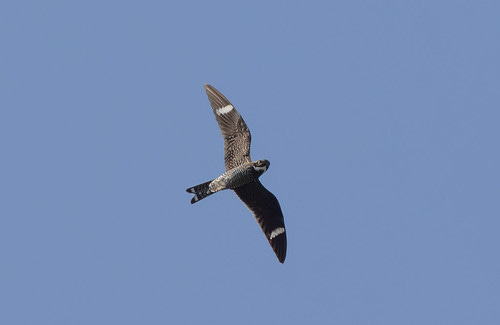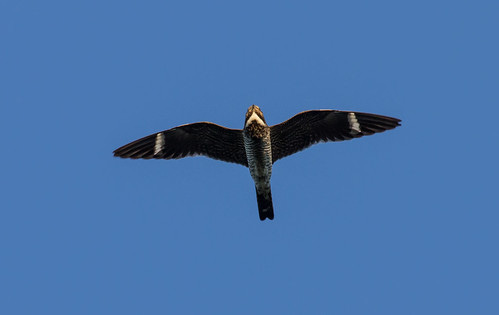(Listen to the radio version here.)
Last Saturday, August 19, Duluth birders started sending texts about dozens, then hundreds, of nighthawks coursing over. When I glanced up in my own backyard, I saw mostly Ring-billed Gulls darting this way and that, like oversized nighthawks fly-catching in a slightly less buoyant, more sluggish manner, but then I picked out a few more diminutive nighthawks among them. Little by little, the gulls disappeared and the nighthawks took over. I counted steadily for one hour, tallying 30 Ring-billed Gulls and 130 Common Nighthawks. It was a lovely and welcome sight.
Nighthawks became one of my favorite birds the night I saw my first one, at 9:00 pm, right around sunset, on June 23, 1975, from the parking lot of the Natural Resources building on the Michigan State University campus. Russ had some work to finish in his office and I was supposed to be studying, but a mysterious sound stopped me in my tracks. Four dark, slender birds making peent calls were darting this way and that in the sky, their even more slender wings bearing a crescent patch of white a short distance from the pointed tip. I sat down on a parking block to watch them. We’d arrived right at sunset, when the four birds were staying about 200 feet above the ground, but as twilight slipped into dusk, they came lower and lower until they were mostly hunting 10–30 feet above the ground. (I probably wouldn’t remember most of these details but I had my ornithology class field notebook with me.) Mosquitoes and lots of other insects were swarming around my head and, as I wrote in my field notes, “Two nighthawks came within one foot of my head.” Imagine that!
One bird suddenly plunged toward earth. Just before it hit, it made a strange, deep gasp or scream as if it suddenly realized it was going to die and managed to veer off at the last nanosecond before impact. I was taking a summer ornithology class and had already read a little about Common Nighthawks, but had to watch this bird repeat that stunning aerobatic move two or three times before I realized it wasn’t really panicking about hitting the ground. I looked up the behavior the next day—this bird was making its courting and territorial “booming” display, the sound not a vocalization, but air rushing through the male’s primary wing feathers when he suddenly flexed his wings downward at the bottom of the dive, veering up at a 60° angle. As National Geographic’s “Extraordinary Birder” Christian Cooper would say, “Fantabulous!”
Nighthawks were a treasured element of my May, June, and July evenings in Madison, Wisconsin, and then, especially, here in Duluth. For many human generations, nighthawks nested on flat rooftops, and in Duluth they were especially abundant downtown and on the UMD and College of St. Scholastica campuses, but strays would hunt over Peabody Street occasionally, too. Their peents and occasional booms were such a comfortable, homey sound, yet far from what kept nighthawks deeply embedded in my heart and soul. Their beloved status came from a much more personal experience.

It all started in June 1989 when I rehabbed a male who’d broken his wing in a collision with a power line, probably during a booming display. When I was describing what was so splendid about him for a “For the Birds” program, I wrote:
I love this bird for his quiet dignity and his gentle manners. He spends his time sitting quietly in the windowsill of my writing room. When I come over by him, he sidles up to me with the typical “Charlie Chaplin gait” peculiar to this species and actually sits on my lap. He’s so companionable that I’ll miss him heartily when I set him free. But nighthawks are birds of the night sky, and although he’s found himself in a strange new world for a short time, I can sense how much he yearns to go back to the starry sky.
His wing was healed and he was ready to go on an August evening when thousands of nighthawks were coursing over my backyard. Russ came outside with me to release him. It was painfully sad to bid farewell to this beloved companion. When I opened my hands, he didn’t take off right away, but sat there for over a minute looking at the sky, and at me, and at the sky again. Then he stretched his wings a couple of times before lifting off ever so delicately and heading straight for the setting sun—the direction all the nighthawks were streaming to clear Lake Superior. Just before I lost sight of him blending in with so many other birds, he turned and flew straight back to me, circled around my head two or three times, and made eye contact. Then he flew on toward the rest of his life.
That amazing farewell still seems so improbable on so many levels that I don’t think I would have believed it was happening even in the moment had not Russ been standing at my side the whole time to witness it.
That happened 34 years ago now, but to this day, I can’t look at nighthawks winging their way through the sunset sky without thinking about him. I may have fixed his wing, but that lovely bird gave me ever so much more.








Thank you, Laura! A remarkable experience. It brought tears to my eyes.
Beautiful